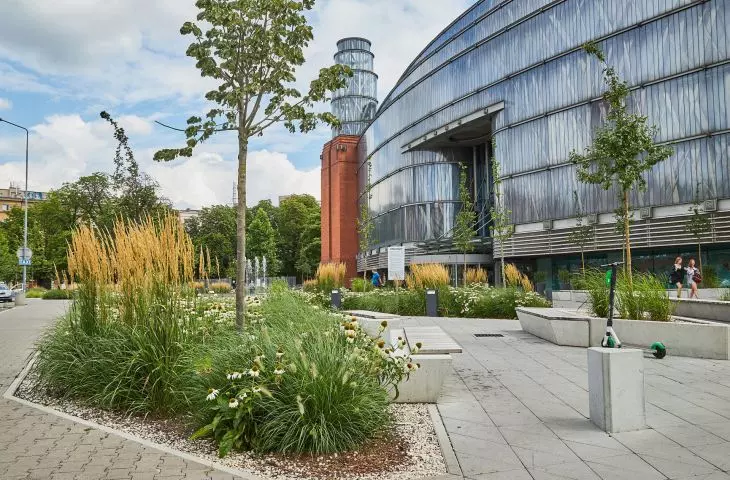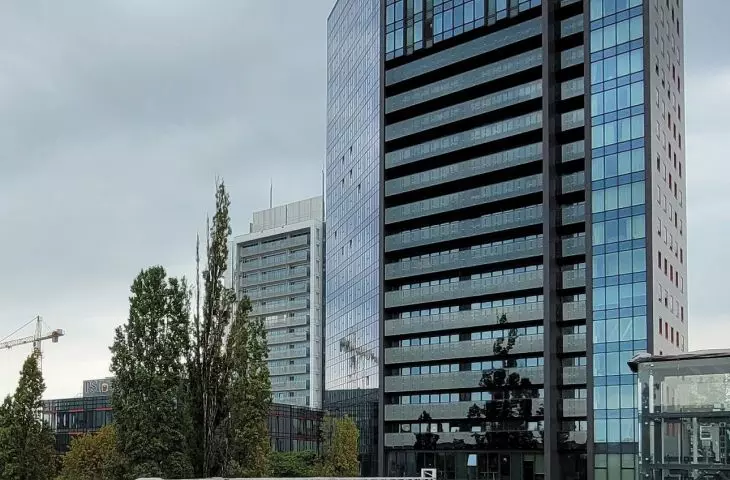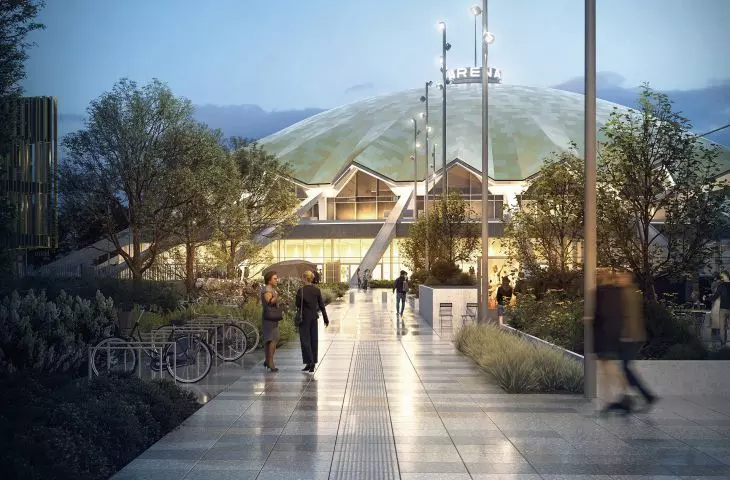Speaking of offices, it is essential to mention the new and very successful icon of Poznań, the Bałtyk office building (design MVRDV, 2017), which marks its presence not only at the Kaponiera traffic circle, but also closes aptly numerous view axes. For more than a year now, the tallest residential building in Poznań (73 meters) on the other side of the railroad tracks, next to the station, has been a height counterweight to this dominant feature. The Ewa and Stanislaw Sipinski Architectural Studio has here significantly exceeded the average level of its numerous architectural productions (including Andersia Silver, the tallest skyscraper in Poznan's Anders Square complex, which is currently under construction). Downtown office architecture also includes very successful buildings on Za Bramka Street (proj. Ultra Architects, 2017) or a more modest building on the corner of Małe Garbary and Bóżnicza Streets (proj. Insomia, 2015).
Worse than the latest offices is Poznań's residential architecture, which can throw one into cognitive dissonance. On the one hand, it is necessary to note a few raisins that also stand out on a national scale, but on the other—to emphasize the enormous misery of the much larger residential mass kneaded by developers and architects hired by them. Thus, the realizations of Szymon Januszewski's Insomia studio (with the Nowy Strzeszyn estate at the forefront) should be appreciated first, followed by designers from Ultra Architects. In third place seems to be Litoborski+Marciniak office.
Wildecki Market 3—the tenement at the corner of Wildecki Market and Przemyslowa Street is one of the best residential developments in the city—it has thoughtfully and successfully created a northern frontage of the square that has not existed before; design: Ultra Architects (realization: 2021); the building honored with the Architectural Award of the Wielkopolska Region in the category „multi-family building” and an honorable mention in the J. B. Quadro competition.J. B. Quadro competition for the best realization of the year
photo: Dawid Majewski
A sad view, however, is presented by the cramped and unattractive buildings in, among others, Polanka/Łacina and the so-called New Jeżyce, which once raised great hopes. The situation is similar in the more distant Marcelino or Podolany districts. Architecture there varies in quality, with the majority of achievements at best average, but urban planning fails all the way. In Poznan, it is quite common to pass local plans for residential development when most administrative decisions have been issued for the area anyway. Such „plans for the past” clearly favor investors, not the urban fabric.
Thus, Poznań is already covered by local plans by more than 50 percent, which is some success in relation to the national average of a measly 32 percent, but in the case of planning, however, the important question is not only „how much?” but also „where?” and „when?”. Thus, for example, the areas where a housing offensive has been going on for years (this is the case in Marcelina and next to the Central Station on Towarowa and Składowa Streets) remain unplanned. The preparation of a plan for the very important area of the so-called Wolne Tory (after a competition decided in 2015!) and several other important areas is also dragging on for years. In the case of the Free Tracks, not only is there no plan, but also no ambition to create a model district in this downtown area, prepared, for example, using the creatively developed Wroclaw experience of the New Żerniki. An excuse here may be the fact that much of the land belongs to railroaders.
Silver Andersia—the city's tallest skyscraper is to reach 116 meters; the project by Ewa and Stanislaw Sipinski Architectural Studio is the last element of the complex of office buildings under construction since the beginning of this century at Andersa Square—visualization, view from the north, from the park near the Stary Browar shopping center, the new skyscraper—on the right; planned completion: 2025
© Pracownia Architektoniczna E. i S. Sipinski
On the other hand, it must be acknowledged that the quality of local plans and the preceding analyses prepared by the Urban Planning Studio has been improving for several years. This also applies to the ongoing update of the Study of Conditions and Directions for Spatial Development, in which—reasonably enough—it is planned to allow a residential function in place of declining shopping centers. Local plans also protect most modernist neighborhoods from uncontrolled overdevelopment or development, as well as, very importantly, green wedges, i.e. natural strips cut deeply into the city, connected with suburban forests. Constantly, however—in accordance with imperfect laws—planning is influenced by the fear of multimillion-dollar compensation that would have to be paid to landowners if the plans conform more to the rules of urban planning than to the immediate economic calculus.
Sometimes the magistrate's pro-investment attitude stems from skillfully exploited fears that—without imminent investment—any of the historic but abandoned parts of the city will continue to deteriorate and frighten with emptiness. This includes the case of the historic Old Slaughterhouse. After more than a dozen years, work is now being finalized on a plan for this studious complex, coinciding with the investor's very intensive plans. It is significant that at the conference he called, Mayor Jaskowiak did not sit among the guests, but... appeared „on stage” together with the developer, and the latter acted as if the plan had already been passed. Meanwhile, the Municipal Urban Planning and Architectural Commission has submitted almost thirty comments to the document, including some very significant ones. Of course, the mayor has the right to reject most or all of them, but it will be a significant gesture.
The controversy over the adaptation of the old fabric, by the way, also concerns, among other things, the former Old Town Hospital on Szkolna Street. The French company Orpea, which specializes in furnishing „senior centers,” bought the building from the city a few years ago at a fairly low price that took into account strict preservationist guidelines. Later, for reasons that are not very clear, the city canceled these strictures. Now the withdrawing owner is trying to sell the partially demolished but unreconstructed former medical center haunting just off the Old Market. I wonder at what price?
The intimate residential complex Murawa 2 is another project of Insomia Szymon Januszewski's studio, which creates the best multi-family buildings in Poznań—the under-construction premise resembles the Nowy Strzeszyn estate by the same designers, which is just being finished, but has a higher standard.
vision: Insomia
In such a pro-investment atmosphere, it comes as no surprise that the Jan Baptista Quadro award for the best architectural realization of the year was presented by the mayor last fall not as usual at City Hall or the current seat of the city government, but during a developers' congress at the Poznań Fair.
And what about cultural and public facilities? Here most projects are still in the starting blocks. Before two years ago, only two decent adaptations of existing buildings managed to be put into operation. The first is the Enigma Cipher Center in the former PZPR provincial committee (proj. New Amsterdam, 2021). The second is the first-ever (!) headquarters of the distinguished Polish Dance Theater in a rebuilt tenement on Taczaka Street (proj. MOM Architects, ARPA Jerzy Gurawski, 2020). On the other hand, the Musical Theater (2019 competition, proj. Atelier Loegler Architects), the Museum of Wielkopolska Uprising (2019 competition, proj. WXCA) and the Museum of Urban Communication with a cultural and social part (here there is not even a finalized project) are waiting for realization (and financing). At the end of the list is—the most vague of these intentions—the Poznan Philharmonic building, known as the Music Center in working order, which is to stand on the Fairgrounds, which is finally being opened to Poznanians (in December a new city square above the multilevel parking lot was made available to MTP). For financial reasons, the very well-prepared (designed by CDF Architects) modernization and expansion of the iconic Arena sports and entertainment hall from 1974 (designed by Jerzy Turzeniecki and his team) has been delayed.
The momentum in building new edifices for universities has also waned in recent years: at present, adaptations and discrete expansions of buildings in the center for the University of Arts and the private School of Banking are mainly underway. The exception to this is the successful new edifice of the Collegium Pharmaceuticum on Marcelinska Street (designed by Rysy Architects) on the Medical University campus. The lack of other new buildings is good news, because the quality of academic architecture has hit a trough in Poznań. The evidence is both the buildings of the failed as a whole UAM campus in Morasko (the newest are the dormitories—correct at best) and the Poznan University of Technology campus on the Warta River, which has been under construction for years. Suffice it to say that the remarkably mediocre edifice of the PP Faculty of Architecture (designed by Slawomir Rosolski, 2020) was built there without competition! It is separated from the river by a kind of moat with a temporary parking lot. Boulevards are absent. An excellent example for future designers.
The entrance to the building of the former PZPR Central Committee (later Collegium Historicum UAM) housing the Enigma Cipher Center (designed by New Amsterdam, realization 2021)
photo: Jakub Głaz
The real misery, however, is in the matter of new schools: quantitative and qualitative. Two facilities have been built from scratch in the last three decades: both without competition and with forms that are unlikely to properly shape students' notions of good architecture. A design for a third school is in the pipeline—also, gosh darn it, selected by tender. How much such an approach is worth can be seen in the disaster at the newly built school sports hall in Winogrady in June 2021. The poorly designed roof collapsed during heavy rain. Miraculously, no one was killed. Schools in neighboring municipalities, where several much more interesting buildings have been constructed, fare better. Anyway, when describing Poznań, one must remember that tens of thousands of residents have moved to the sprawling agglomeration. The challenge now, therefore, is to connect the city well with its adjacencies—especially using the growing Poznań Metropolitan Railway.
project for the reconstruction of the Arena sports and entertainment hall in Kasprowicz Park by CDF Architects, visualization—the original body of the hall will be preserved, but its interior will be enlarged, among other things, by expansion in level -1
vision: CDF Architekci
So what about the non-functional Central Station? A stalemate continues here. Despite many announcements, to this day the PKP has not restored the station's function to the old building; it has not even announced the hyped competition on the matter. The city has also not pressed PKP hard enough to civilize the scandalous nationwide issue of the dysfunctional and unsightly station. Meanwhile, over the past three (!) years, PKP has built a new platform and a rather breakneck underpass for nearly 100 million zlotys. To make up for it, it has also sorted out the illogical numbering of the platforms as much as possible.
In the field of public transportation in Poznań itself, it is worth noting, in turn, the new streetcar route to the Naramowice district, which was completed last year. Thanks to the streetcar, this incoherently formed part of the city has gained a transportation backbone, which to some extent civilizes its structure. Poznan, moreover, intends to build more streetcar routes and is renovating the existing network on a grand scale.
The site of the Old Slaughterhouse, whose historic structure is to be heavily densified with residential and office buildings according to a design by JSK Architekci—work is currently underway on a local plan for the entire complex and its surroundings; the Museum of Wielkopolska Uprising is also to be built in the immediate vicinity of the Old Slaughterhouse
photo: Jakub Głaz
Investment in bicycle infrastructure and pedestrian facilities has also accelerated since pandemic 2020. The increase in the number of cyclists on the streets is significant, and cycling in the city is finally starting to become sensible and safe. The Wartostrada, or pedestrian and bicycle routes on both sides of the Warta River, is also growing. Both these and other riverside investments have finally turned Poznań towards the river. Unfortunately, the construction of an important pedestrian and bicycle crossing, known laboriously as the Berdychowska Footbridge, which will connect the Old Town to the Polytechnic, and further to Lake Malta (2018 competition, proj. consortium composed of ARPA Architektoniczna Pracownia Jerzy Gurawskiego, Błażej Szurkowski, Maciej Sokolnicki and Adam Turczyn).
The infrastructure itself, moreover, is not everything, it is necessary to improve traffic organization. The current one does not allow to use all the advantages of new investments. The quality of the workmanship of the renovated squares and streets is also limping, which makes one look critically at the activities of the Poznań Municipal Investments company, which oversees the construction. But what to expect when its vice president became (without competition) in 2019 the former secretary and trusted advisor of Jaskowiak, the then twenty-eight-year-old Marcin Golek—with no experience in investments and no track record in public communications, which he is supposed to be responsible for in PIM. His monthly salary of up to PLN 46,000 gross is an effective demotivator for experienced officials working for paltry salaries in the municipality.
In fact, with the money spent on the post for Golek, space could be effectively arranged for the display of the city's planning intentions and architectural education in the broadest sense. However, decision-makers do not feel the need to establish a place similar to even Warsaw's Zodiac or Gdynia's InfoBOX. It is even difficult to judge whether this is thoughtlessness or deliberate action. On the one hand, without decent information and discussion, it is easier to push through both municipal and developer investments, on the other—without public discussion preceding action, one also reaps greater blowback after the investment is completed. As is happening right now. Will dissatisfaction translate into the outcome of next year's elections? Not necessarily. So far, Jaskowiak has not sprouted any solid counter-candidate.











































